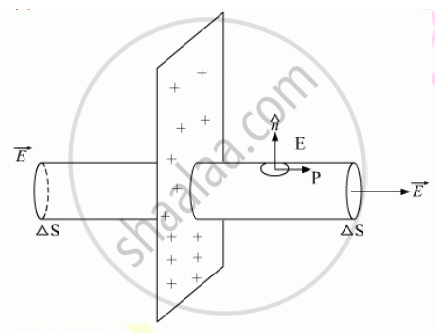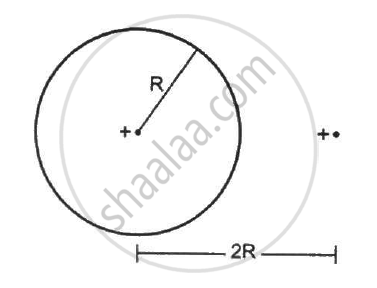Advertisements
Advertisements
Question
Using Gauss’s law, prove that the electric field at a point due to a uniformly charged infinite plane sheet is independent of the distance from it.
Solution

Consider a uniformly charged infinite plane sheet of charge density σ.
We have to find electric field E at point as shown in figure.
Now, we construct a Gaussian surface as shown in figure in the form of cylinder.
Applying Gauss’s Law,
`phi =oint vecE*dvecs =(σΔs)/in_0`
`=> E Deltas + EDelta +0 = (sigma Deltas)/in_0`
`= 2EDeltas = (sigma Deltas)/(in_0)`
`=> E = sigma /(2in_0)`
It shows that electric field is uniform due to charged infinite plane sheet. Also, we can say that E is independent from distance from the sheet.
APPEARS IN
RELATED QUESTIONS
Two large, thin metal plates are parallel and close to each other. On their inner faces, the plates have surface charge densities of opposite signs and of magnitude 17.0 × 10−22 C/m2. What is E:
- in the outer region of the first plate,
- in the outer region of the second plate, and
- between the plates?
Find the ratio of the potential differences that must be applied across the parallel and series combination of two capacitors C1 and C2 with their capacitances in the ratio 1 : 2 so that the energy stored in the two cases becomes the same.
An infinitely large thin plane sheet has a uniform surface charge density +σ. Obtain the expression for the amount of work done in bringing a point charge q from infinity to a point, distant r, in front of the charged plane sheet.
Using Gauss's law in electrostatics, deduce an expression for electric field intensity due to a uniformly charged infinite plane sheet. If another identical sheet is placed parallel to it, show that there is no electric field in the region between the two sheets ?
A point object is placed on the principal axis of a convex spherical surface of radius of curvature R, which separates the two media of refractive indices n1 and n2 (n2 > n1). Draw the ray diagram and deduce the relation between the object distance (u), image distance (v) and the radius of curvature (R) for refraction to take place at the convex spherical surface from rarer to denser medium.
Using Gauss’ law deduce the expression for the electric field due to a uniformly charged spherical conducting shell of radius R at a point
(i) outside and (ii) inside the shell.
Plot a graph showing variation of electric field as a function of r > R and r < R.
(r being the distance from the centre of the shell)
How is the field directed if (i) the sheet is positively charged, (ii) negatively charged?
A positive point charge Q is brought near an isolated metal cube.
Find the flux of the electric field through a spherical surface of radius R due to a charge of 10−7 C at the centre and another equal charge at a point 2R away from the centre in the following figure.

A circular wire-loop of radius a carries a total charge Q distributed uniformly over its length. A small length dL of the wire is cut off. Find the electric field at the centre due to the remaining wire.
